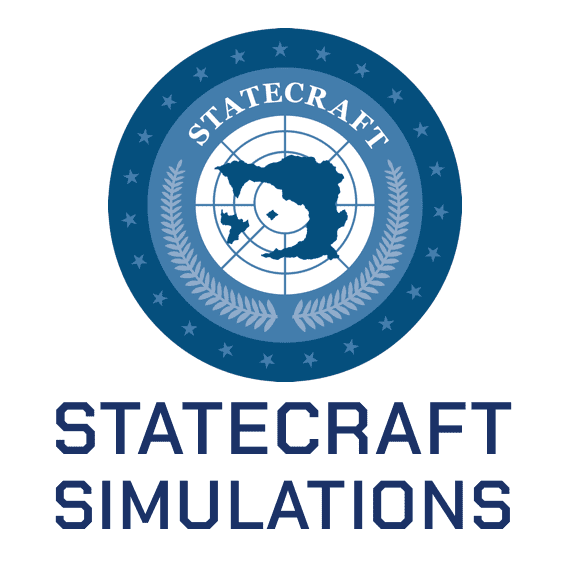The Statecraft International Security simulation is an excellent fit for courses using textbooks like “The Oxford Handbook of International Security” and “International Security: A Very Short Introduction” due to its immersive and practical approach to understanding complex international security issues. Here’s how it aligns well with these textbooks:
- Asynchronous & Online: Runs itself 24/7 for 7 to 10 weeks
- Super Support: Statecraft Help was rated 4.84 of 5 stars
- AI Plagiarism Proof: Student led butterfly effect creates thousands of potential outcomes making it impossible for AI to generate simulation security briefing assignments each week.
Launch the Interactive Tour to
see the sim interface in action
and learn how gameplay works.
Launch the Interactive Tour to see the sim in action and learn how gameplay works.
The Statecraft International Security simulation is an excellent fit for courses using textbooks like "The Oxford Handbook of International Security" and "International Security: A Very Short Introduction" due to its immersive and practical approach to understanding complex international security issues. Here's how it aligns well with these textbooks:
“The Oxford Handbook of International Security”: This textbook offers a broad survey of both innovative research and traditional areas of international security. The Statecraft simulation provides an interactive platform where students can explore these diverse topics in a practical setting, simulating scenarios that reflect the complex dynamics discussed in the book. This hands-on approach helps students apply theoretical concepts to real-world-like situations, deepening their understanding of international relations and security issues.
“International Security: A Very Short Introduction”: This introduction outlines key debates and challenges in contemporary international security, such as military strategy, nuclear proliferation, and peacekeeping. The Statecraft simulation enhances these themes by allowing students to engage directly with simulated security crises and strategic decision-making processes. This practical experience makes the abstract concepts more tangible and accessible, bridging the gap between theoretical study and practical application.
“Security Studies: An Applied Introduction”: Known for its practical approach, this book equips students with tools to analyze and engage with modern security challenges. The Statecraft simulation complements this by offering students a dynamic environment to apply what they’ve learned. They can tackle issues like cyber warfare, terrorism, and international diplomacy within the simulation, experiencing firsthand the complexities of security in a global context.
Strategy
To gather points students can pursue a myriad of strategies: from avoiding conflict for domestic wellbeing to cautiously collaborative strategies that maximize economic synergies while carefully checking other country's imperial motives. It is possible that every country could get a perfect score and all thrive; however (just like in the real world) that rarely happens.
Goals
Each turn students try to achieve three types of goals: (1) Cooperative Global Goals that are shared with the entire world such as ending world hunger; (2) Competitive Country Goals for excelling in a certain area such as “Most Militarily Powerful” and finally (3) Country Development Goals based on domestic factors such as citizens' health, welfare, environment, safety and education. (4) Secret Goals only their country knows about which may cause them to act in ways that create national security challenges and realist dilemmas throughout the simulation.
Domestic Factors
Every turn countries will produce resources students must decide how to invest; they’ll bump up against the classic “guns vs. butter” conundrum. They’ll also get a Quality of Life score that equates to points for their citizens' health, welfare, environment, safety and education. Unhappy citizens riot! Unhealthy citizens die of famine!
International Factors
There are pirates terrorizing the world! Ice Mountain is melting, drug cartels are decreasing healthcare ratings, and there are rumors of human trafficking! Should students utilize the U.N.? Can students navigate everyone’s hidden motives? Will students utilize soft or hard power to make their strategy unfold?
Statecraft IS creates situations where students are experiencing course concepts on a personal level and must apply the lessons they’ve learned in class to succeed. Along the way they’ll have questions about situations in the simulation like collective security or mutually assured destruction that will become prime teachable moments.
Regardless of their world ranking every student will grapple first-hand with the complex mix of international and domestic pressures that world leaders face, finishing with a much deeper understanding of International Security.
Statecraft empowers you to transform your class into an immersive, unforgettable learning experience you’ll enjoy just as much as your students.

Demonstrate Course Concepts
Students experience important IS concepts such as security dilemmas and collective action problems first-hand and personally feel how complicated leadership truly is. In order to succeed in the simulation, they’ll have to apply course-related knowledge.

Engage Students
Game-like play sucks students into the simulations where they must take ownership of their learning experience. They’re empowered to excel to their own personal limits and shine. Engagement enhances the knowledge acquisition process and makes it fun!
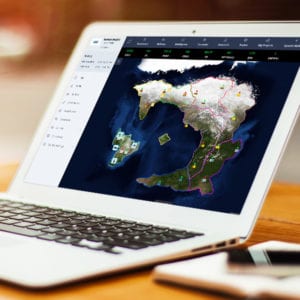
Save Time
The simulation is easy to set up and runs itself. You have a new tool to draw connections to course concepts and spark dynamic conversations. All-unique simulation scenarios every semester promote academic honesty. Instructor tools do tasks like grading for you.
student map interface
The Statecraft World Map is where all of the action happens! Students can log in via a desktop computer or a mobile device. The map illustrates the geographical layout of the world showing resource centers, deserts and mountains as well as the climate situation. The colored lines delineate territory zones belonging to each country. The icons mark cities, military units, landmarks and terrorist occupations. Once a student spies on a foreign country those cities and military units will also be exposed. Clicking on the icons reveals more information and there’s a detailed legend key to offer extra map guidance.
In the nav bars at the top students can access all of the critical information for their world as well as look at their intelligence data for other countries. They’ll be able to access their Diplomacy, Military, Intelligence, Domestic and Research activities as well as manage their Resources.
Diplomacy - National Security
- Utilize Hard or Soft Power
- Build a Sphere of Influence
- Forge Collective Security Agreements
- Build Defensive Posture in your world
Military
- Enhance military technological capabilities
- Strategically build their national defense strategy
- Build and maintain a navy, air force, and army
- Forge collective security alliances
Intelligence
- Spy on other countries domestic politics, economy, and military capabilities
- Build counter-intelligence capabilities to limit spying in their own country
- Run overt operations to sabotage and undermine other countries
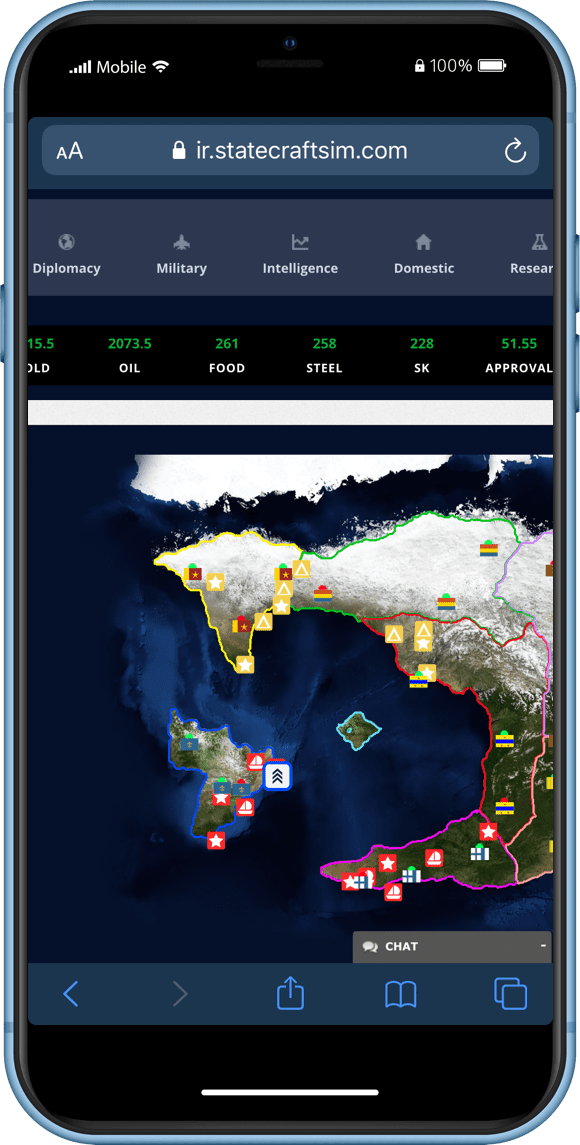
Domestic
- Enhance your Citizen’s Healthcare and Unemployment System
- Improve your justice system and environment
- Invest in Public Education and University Systems
- Foster your country’s unique culture and gain tourism points!
Research
- Gain new, powerful technologies that can enhance domestic ratings such as health, safety, the environment, or improve national security
- Trade technologies with other countries to more rapidly develop their Quality of Life and National security
Resources Bar
- Manage economic resources
- Budget for enhancing domestic infrastructure or security
- Trade with other countries and develop relationships with countries that produce needed resources
Time-Saving Instructor Tools
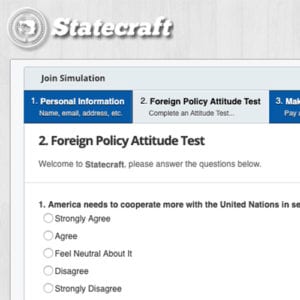
Student Assignments
Statecraft automatically assigns students to roles based on a brief attitude test designed for optimum role fit and student collaboration during the initial signup process.

Automated Student Prompting, Feedback & Calculations
Professors report an average of 13% time savings by using simulation tools that automatically prompt students, issue feedback, and guide outcomes.

Automated Grading
The Statecraft system tracks all choices and outcomes and automatically reports final grades to the instructor in an excel exportable format for your convenience.

Playing the Simulation
- Students are playing to earn points by achieving both the world collective goals and their individual country goals
- Everything is prompted by the system; it tallies points for performance and participation and calculates grades for you at the end of the simulation
- The simulation runs live 24-7 so students can play anytime without you needing to schedule class time or a computer lab
- At the end of each turn the decisions or “moves” students made during the turn actually happen and they can see the results of their actions
- Every turn each country produces resources that can be used to buy military units and domestic structures, trade with other countries, research technology and invest in big projects like Alcatraz or the Louvre
- Students also make strategic decisions such as drafting treaties, forming alliances, engaging in espionage or launching a military attack
- Global issues such as terrorism and climate change will affect all of the countries in the world, requiring collaboration to resolve
The Instructor's Role
- Watch as the students collaborate and compete with one another to be successful and gain the most points
- Act as an executive consultant to help guide students and answer questions about how real-world countries deal with similar challenges through diplomacy, international organizations, economic statecraft, and military action
- Statecraft help desk will assist students with any technical questions or troubleshooting
- Use the simulation events as learning opportunities to draw correlations to course concepts
- See all of the events happening in the simulation by looking at the global map and tracking tools
- Offer students 30+ minutes of class time to meet in their country groups each week to decide on big world moves (recommended but not required)
- If needed you can use a master account to make “godlike” decisions should there be world crisis; as the instructor you always have ultimate control over your simulation world


Conclusion & Grading
- When the last turn ends global goal points are given, individual country points are tallied, awards are bestowed and grades are issued
- The system provides a gradebook showing students’ final point totals in a table that is easily exportable to Excel
- Statecraft also offers suggested assignments (quiz/exam questions, paper topics, and discussion questions) that can count toward students’ course grades
- We recommend a final debrief in which countries present their version of “what happened” so the class and the instructor have insight into all perspectives
- Students can still receive a good grade for participating fully in the simulation even if their country and world collapse due to poor choices (but instructors can modify grades based on apparent effort)
- There are unlimited outcomes possible for the simulation! Every run of the Statecraft IS Simulation result is unique
- Since every class experience is unique, it is difficult for students to “cheat” by relying on outside help or past students’ experiences; In this way, the simulation encourages academic honesty and makes assessments easier for you
If you’re looking for even more detailed information, see the Resources page for the instructor manual, sample syllabus and other helpful documentation.
Let's do this! Experience Statecraft for Yourself
Book your personal demo today! We’ll answer your questions, show you how these cool features work and help you set up your first Statecraft IS Simulation.
Course concepts covered
The multidimensional International Security Simulation program covers all major IS course concepts. Using the simulation creates new opportunities to demonstrate how course concepts come to life. Students are experiencing lessons first-hand so they’re more engaged and develop personal opinions about what they’re learning. Instructors report being able to have more productive lessons and more interesting conversations with students.
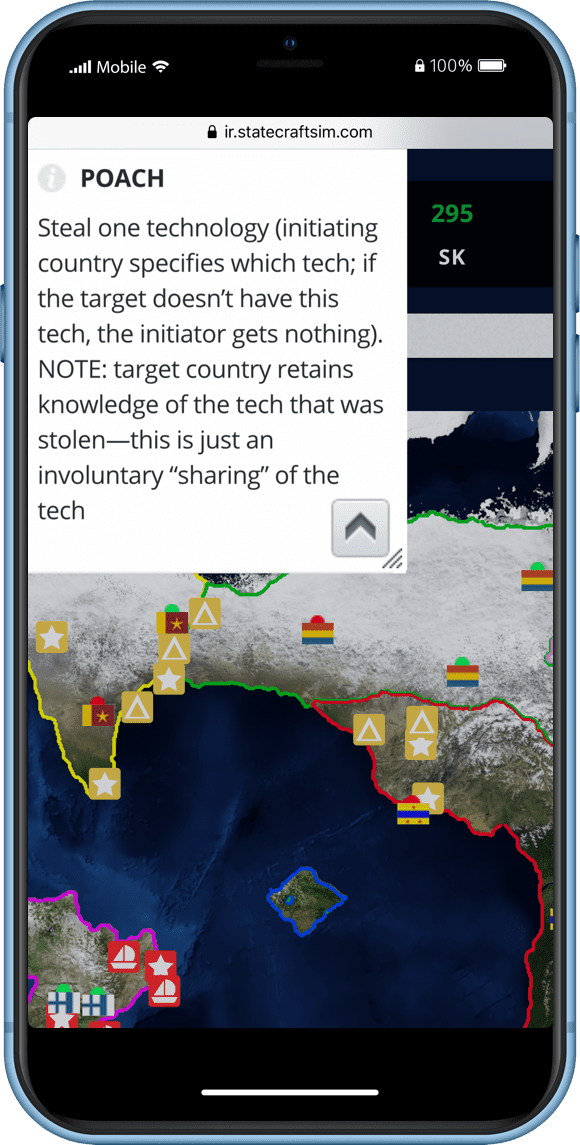
Anarchy
Just War Theory
The Security Dilemma
Terrorism
Problems of Credible Commitment
Nationalism
Deterrence
Genocide
Collective Security
Despots
Mutually Assured Destruction
Torture
Reasons the Statecraft IS Simulation is so effective:
- An innovative way to teach concepts beyond traditional lectures
- Concepts become personal and experienced by students
- Students are engaged and participating both inside and outside of class
- Engagement enhances the knowledge acquisition process
- Students take ownership of their experience and are empowered to shine
- Teaches career skills like leadership, teamwork, negotiation and strategic thinking that help them become more employable
- Students must apply course knowledge and do context-based problem solving to succeed
- Working in teams on common goals fosters student collaboration and relationship building even in large lecture classes


Results you’ll experience:
- Heightened student engagement & greater attendance
- Quality student questions and requests for strategy consultation
- Students are able to discuss course concepts intelligently and develop strong opinions that spark interesting class conversations
- More camaraderie among the students, social connections, sense of community
- Students will form study groups and you’ll hear them speaking about topics such as enforcing UN resolutions or the security dilemma outside the classroom
- Statecraft Simulations promote academic honesty: since every simulation experience is completely unique it’s practically impossible for students to cheat
- Your class popularity will increase due to previous student recommendations
Costs much less than a textbook
Students pay
$39.75
- One-time payment per student per semester
- You assign the simulation to students, give them the activation code and they purchase it just like they would purchase a textbook
- Statecraft cares deeply about facilitating student learning so we keep pricing as accessible as possible
"helps Students absorb material"

Get started today to experience how Statecraft brings International Security to life in your course!
You can sign up online now to get started immediately or book your personal demo! We’ll give you a complete product tour, answer all of your questions and help you configure your first Statecraft IS Simulation.
Let's Keep In Touch
Sign up for the Statecraft Newsletter and we’ll send you product updates, simulation tips and exclusive offers straight to your inbox!
The Statecraft International Security simulation is an excellent fit for courses using textbooks like "The Oxford Handbook of International Security" and "International Security: A Very Short Introduction" due to its immersive and practical approach to understanding complex international security issues. Here's how it aligns well with these textbooks:
“The Oxford Handbook of International Security”: This textbook offers a broad survey of both innovative research and traditional areas of international security. The Statecraft simulation provides an interactive platform where students can explore these diverse topics in a practical setting, simulating scenarios that reflect the complex dynamics discussed in the book. This hands-on approach helps students apply theoretical concepts to real-world-like situations, deepening their understanding of international relations and security issues.
“International Security: A Very Short Introduction”: This introduction outlines key debates and challenges in contemporary international security, such as military strategy, nuclear proliferation, and peacekeeping. The Statecraft simulation enhances these themes by allowing students to engage directly with simulated security crises and strategic decision-making processes. This practical experience makes the abstract concepts more tangible and accessible, bridging the gap between theoretical study and practical application.
“Security Studies: An Applied Introduction”: Known for its practical approach, this book equips students with tools to analyze and engage with modern security challenges. The Statecraft simulation complements this by offering students a dynamic environment to apply what they’ve learned. They can tackle issues like cyber warfare, terrorism, and international diplomacy within the simulation, experiencing firsthand the complexities of security in a global context.
